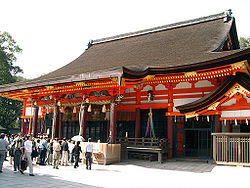Yasaka Shrine
Yasaka Shrine (八坂神社, Yasaka-jinja), also known as Gion Shrine (祇園神社, Gion-jinja), is a shinto shrine located in the Gion District of Kyoto, Japan. It is the central shrine of Gion worship. It sits at the east end of Fourth Avenue and has various buildings such as gates, a main hall, and a stage. The shrine worships Susanoo as its main deity, along with his partner Kushinadahime on the east and eight other gods known as yahashira no mikogami on the west. These eight gods include Yashimajinumi no kami, Itakeru no kami, Ōyatsuhime no kami, Tsumatsuhime no kami, Ōtoshi no kami, Ukanomitama no kami, Ōyatsuhiko no kami, and Suseribime no mikoto..[1]
| {{{building_name}}} | |
|---|---|

Yasaka Shrine | |
| Basic information | |
| Location | Gion, Kyoto, Japan |
| Affiliation | Shinto |
| Architectural description | |
| Specifications | |
History
The Shrine was first built in 656 and during the early Heian period, it gained support from the Imperial family..[2] In 965, Emperor Murakami ordered the practice of presenting heihaku, or offerings of white cloth, to the guardian kami of Japan to report important events. Initially, these offerings were presented to 16 shrines.;[3] In 991, Emperor Ichijō expanded the list of shrines to which important events were reported to by adding three more shrines to the existing 16 on Emperor Murakami's list. Three years later, in 994, Emperor Ichijō further refined the list by adding Umenomiya Shrine and Gion Shrine..[4]
From 1871 to 1946, Yasaka Shrine was recognized as one of the Kanpei-taisha (officially ranked Imperial shrines), which placed it in the highest tier of government-supported shrines..
Matsuri
In 869, Japan suffered from a severe epidemic, and the Emperor believed it was caused by vengeful spirits. To calm these spirits, a Shinto ritual was performed at Shinsenen, a lake at the Imperial Palace. Representatives used 66 pikes for each of the 66 regions in the country at that time. This ritual was known as goryo-e, and later became an annual event called the Gion Matsuri, associated with the Gion Shrine in Kyoto. Over time, the pikes were decorated and became larger, eventually evolving into the well-known Gion Matsuri yamaboko floats..[5] During the Gion Matsuri festival, the decorated Gion Matsuri yamaboko floats and portable shrines from Yasaka Shrine travel through the main streets of Kyoto to purify them and protect against epidemics and other harm. This festival takes place every July and has gained global recognition.
Yasaka Shrine is a popular destination for people to celebrate traditional Japanese New Year rituals and for cherry blossom viewing in April, as crowds pass through the temple on their way to Maruyama Park. The shrine also hosts lanterns on its stage which display the names of festival sponsors.
Gallery
The mikoshi of the Yasaka shrine, displayed for part of the Gion Matsuri in the second week of July.[6]
Other pages
Sources
- ↑ "Mikogami". Encyclopedia of Shinto. 21 April 2005. Retrieved 29 September 2019.
- ↑ Breen, John et al. (2000). Shinto in History: Ways of the Kami, pp. 74-75.
- ↑ Ponsonby-Fane, Richard. (1962). Studies in Shinto and Shrines, pp. 116-117.
- ↑ Ponsonby-Fane, Shrines, p. 118.
- ↑ Pawasarat, Catherine (July 2020). The Gion Festival: Exploring Its Mysteries (1st ed.). Independent. ISBN 978-0-9985886-6-7. Retrieved 2 December 2022.
- ↑ Pawasarat, Catherine (July 2020). The Gion Festival: Exploring Its Mysteries (1st ed.). Independent. p. 28. ISBN 978-0-9985886-6-7. Retrieved 2 December 2022.
Books
- Breen, John and Mark Teeuwen. (2000). Shinto in History: Ways of the Kami. Honolulu: University of Hawaii Press. ISBN 978-0-8248-2363-4ISBN 978-0-8248-2363-4
- Ponsonby-Fane, Richard. (1962). Studies in Shinto and Shrines. Kyoto: Ponsonby Memorial Society. OCLC 399449
- ____________. (1959). The Imperial House of Japan. Kyoto: Ponsonby Memorial Society. OCLC 194887




